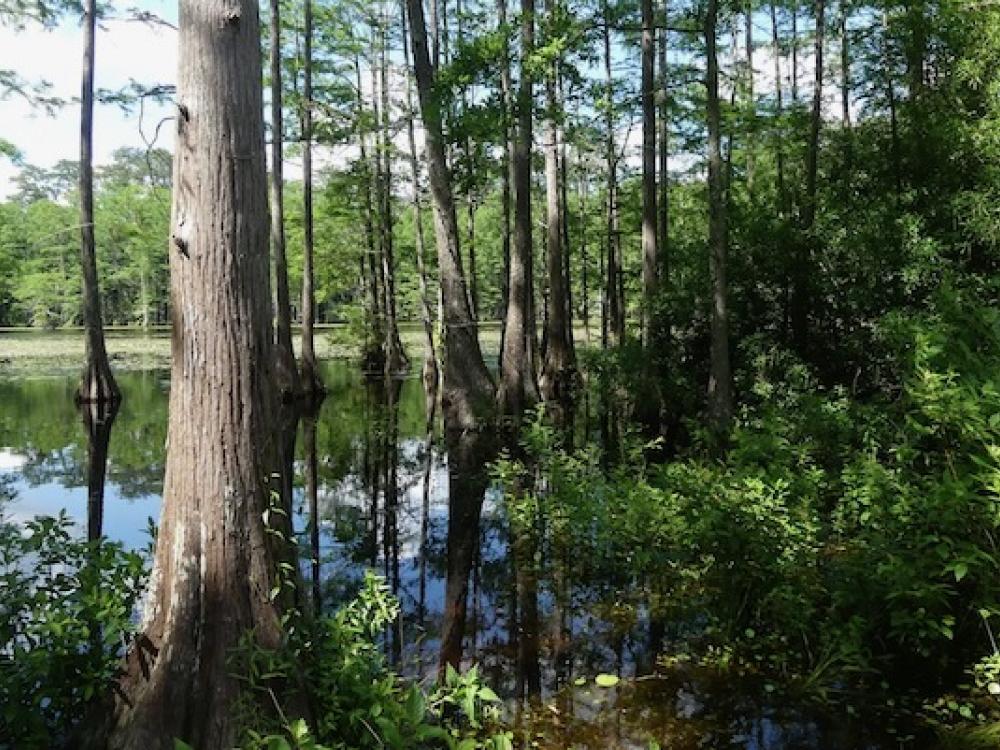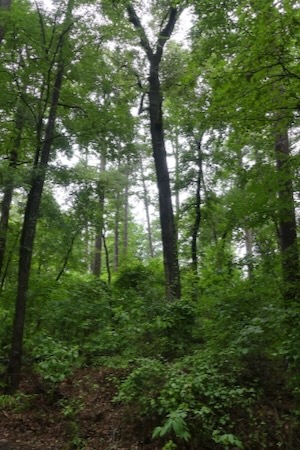
Reporter Michael Smith recently retreated to the Big Thicket for peace and quiet. Photo by Michael Smith.
July 27, 2023
Two days in the Big Thicket in Southeast Texas had been beautiful and quiet. Off the porch of our cabin, Ruthann and I could listen to the melodic songs of birds and the calls of frogs. The spaces between the sounds were quiet — noticeably quiet for us city folks.
I could hear the creak of the wooden stairs as I walked down to the water’s edge. I listened to the breeze as it passed through the pine trees. Within the quiet, I could hear the natural life around me. Between the sounds, my mind could rest.
And then on the last morning, somebody’s country music radio came blasting through the woods. As we sat drinking coffee, the neighbor a few hundred yards away fired up his chainsaw. And then the dogs got started — barking and barking in answer to the radio and the chainsaw.
Modern life in many parts of the world is full of the sound of human activity. Suburban bliss is often disturbed by blaring leaf blowers and rumbling delivery trucks. Overhead, the drone of airliners, military jets and small private planes fills the air. Staying indoors, we enjoy the coolness of air conditioning while enduring the system’s constant drone.
For many of us, the noise almost never stops. The highway traffic never stills, trains pass in the distance and then there’s a TV on somewhere.
IS HUMAN-GENERATED NOISE NORMAL, A PROBLEM OR BOTH
The noise that I am describing is common and most of it is below the level that typically leads to hearing loss. So what’s the big deal?
An editorial in the prestigious medical journal The Lancet defined noise pollution as unwanted or disturbing sound and said that it was dangerous to public health. Beyond the damage that loud sounds can do to our hearing, noise is “associated with an increased incidence of cardiovascular diseases in addition to causing annoyance, disturbed sleep and impaired cognitive performance.”
In Title IV of the Clean Air Act, the U.S. Environmental Protection Agency used the same definition of noise pollution and listed several problems associated with such noise. These included: stress related illnesses, high blood pressure, interference with speech, hearing loss, sleep disruption and lost productivity.
What about wildlife? What about the open spaces away from cities where we imagine there is plenty of “peace and quiet?”
A 2017 article in Science talked about anthropogenic (human-caused) noise in protected places. The authors noted that noise adversely affects wildlife as well as humans, and that noise impacts some animals’ ability to perceive natural sounds.
For many species, hearing is important to detecting prey (and avoiding predators), as well as finding and selecting mates. The article found that anthropogenic noise is present even within protected areas. It is lower in federally protected areas such as national parks and wilderness areas, and higher in places managed by local governments or private agencies. Anthropogenic noise “is pervasive in [protected areas] near developed areas, where noise surpassed levels known to affect humans and wildlife.”
ONE SQUARE INCH OF SILENCE
The ongoing disappearance of natural quiet led acoustic ecologist Gordon Hempton to travel around the U.S. in search of some place where he could listen for 15 minutes and not hear a human sound.
There are few such places remaining. He found what he suspects is the quietest place in the U.S. in the Hoh Rain Forest of Olympic National Park, west of Seattle. The quiet in that place is not the absence of sound, but the full presence of natural sound, not masked by anthropogenic noise.
Within the rain forest, Hempton marked the quietest square inch with a small red stone (read Kathleen Moore’s thoughtful and insightful description of a visit to that very spot in Orion magazine).
Where are the quiet places in Texas? I’ve traveled over most of our state, and I’ve found a few. Many are in national parks, such as in the Chisos Mountains in Big Bend National Park. Sometimes a jet passes high overhead, but often you can sit on a mountain trail and hear nothing but bees and bird song, or perhaps distant thunder.
I once hiked up to Smith Spring in Guadalupe Mountains National Park and sat in the shade of the oaks and madrones in that little oasis and listened to bees visiting a scarlet penstemon beside a crystal clear spring fed pool. Except for occasional distant air traffic, the bees had nothing except the sound of my breathing to compete with them.
Closer to home, there are quiet places once you get away from cities and highways.
I wrote about an autumn walk in the LBJ National Grasslands for a forthcoming book, describing how we could hear a “rolling wave of moving air as the breeze rose up and dislodged a few more leaves. We could sometimes even hear them hitting branches as they dropped to the ground.”
The book is about practicing mindfulness in nature, and when I talked about a nearby urban preserve I included some discussion of my struggling with highway noise and air traffic there. I wrote:
“A bird was calling nearby, a sweet rising and falling song, layered within the ongoing sound of the nearby freeway. The thought that arose was, How much sweeter and clearer that song would be in a quiet woods. …. Noise affects birds, too. They either avoid noisy areas or may call differently because they cannot hear details and nuances when there is noise. Such environments can be stressful for them, too. So my thought was correct, but it also kept me stuck in a perpetual wish for things to be different than they were. Once again, I would be better off letting that thought go.”
In most of my visits to that preserve, I am able to let such thoughts go and accept what is. Most of the time, but not always.
WHAT’S PRIVILEGE GOT TO DO WITH IT?
Some might think I should just be glad I’ve got a local preserve to go to. They have a point and I am grateful for those wonderful 52 acres.
But others might go further and suggest that I stop complaining. They might say that whining about noise from nearby highways and jets reflects the overly-sensitive concerns of the privileged who have enough money and time to seek out such places.
I actually don’t have much money, and I don’t believe that being able to experience natural quiet should be about privilege.
If we were talking about access to nutritious food, most people would agree that everyone should have access to good food. Similarly, I believe that all of us should have access to time in nature without noise from traffic, air conditioning, oil and gas equipment, and so on. Remember that chronic exposure to such noise is linked to health problems, poor sleep and impairment in learning and thinking.
All of us should have access to time in nature without noise from traffic, air conditioning, oil and gas equipment, and so on.
Additionally, there is a growing body of evidence showing that time spent in nature has health benefits such as lowered blood pressure and lower levels of stress hormones, as well as improved mood, better cognitive abilities and better overall well-being. That, in addition to the benefits of natural quiet, is a powerful argument for everyone to be able to find quiet places in nature.
QUIET — FIND IT, ENJOY IT AND PROTECT IT
 The Lennox Woods preserve is a quiet haven in Northeast Texas. Photo by Michael Smith.
The Lennox Woods preserve is a quiet haven in Northeast Texas. Photo by Michael Smith.
My wife and I found a new quiet place very recently. In the northeast corner of Texas is Lennox Woods, an old-growth forest on 1,335 acres protected by The Nature Conservancy.
We arrived shortly after a rainstorm, finding the nature trail at a turn in a narrow dirt and gravel county road.
Jo and I sat in camp chairs under towering pines, oaks and hickories still dripping water from the storm. Occasionally, there was a distant passing jet, but otherwise it was still and quiet. Between the calls of birds we heard the intermittent “pat” of a raindrop hitting the leaf litter after falling from somewhere up in the tree canopy. Nothing else disturbed the peace of the forest.
When you find a quiet place, match it with your own calm and quiet. Listen, even if there is no obvious bird song and no creek with gurgling, rushing water. Quiet and stillness invites an inner peace, a few minutes in which a kind of deep rest can take hold.
The first few times, an urge for input and distraction may push you to move on and find something to fill the space. But if you let yourself stop and appreciate it, a quiet place in nature becomes a real treasure.
We must advocate for the protection of natural quiet. It is easy to overlook anthropogenic noise in a place, as long as it is visually beautiful.
We must advocate for the protection of natural quiet.
Few people even get to see a beautiful prairie, let alone walk through one in which no background noise interferes with the dickcissel’s song or the bumblebee’s buzzing. Sound — and quiet — may be an afterthought when we visit places in nature. It shouldn’t be.
One way to advocate for quiet places is to visit and support Quiet Parks International. We can let those who manage parks and refuges know that minimizing anthropogenic noise is important to us, because such noise can be harmful to wildlife and people. The more we let them know that minimizing noise is important to us, the more motivation such managers may have for protecting quiet.
RELATED ARTICLES
Ban the blower? Gas-powered lawn tools blast suburban bliss
Stay up to date on everything green in North Texas, including the latest news and events! Sign up for the weekly Green Source DFW Newsletter! Follow us on Facebook,Twitter and Instagram. Also check out our podcast The Texas Green Report, available on your favorite podcast app.









